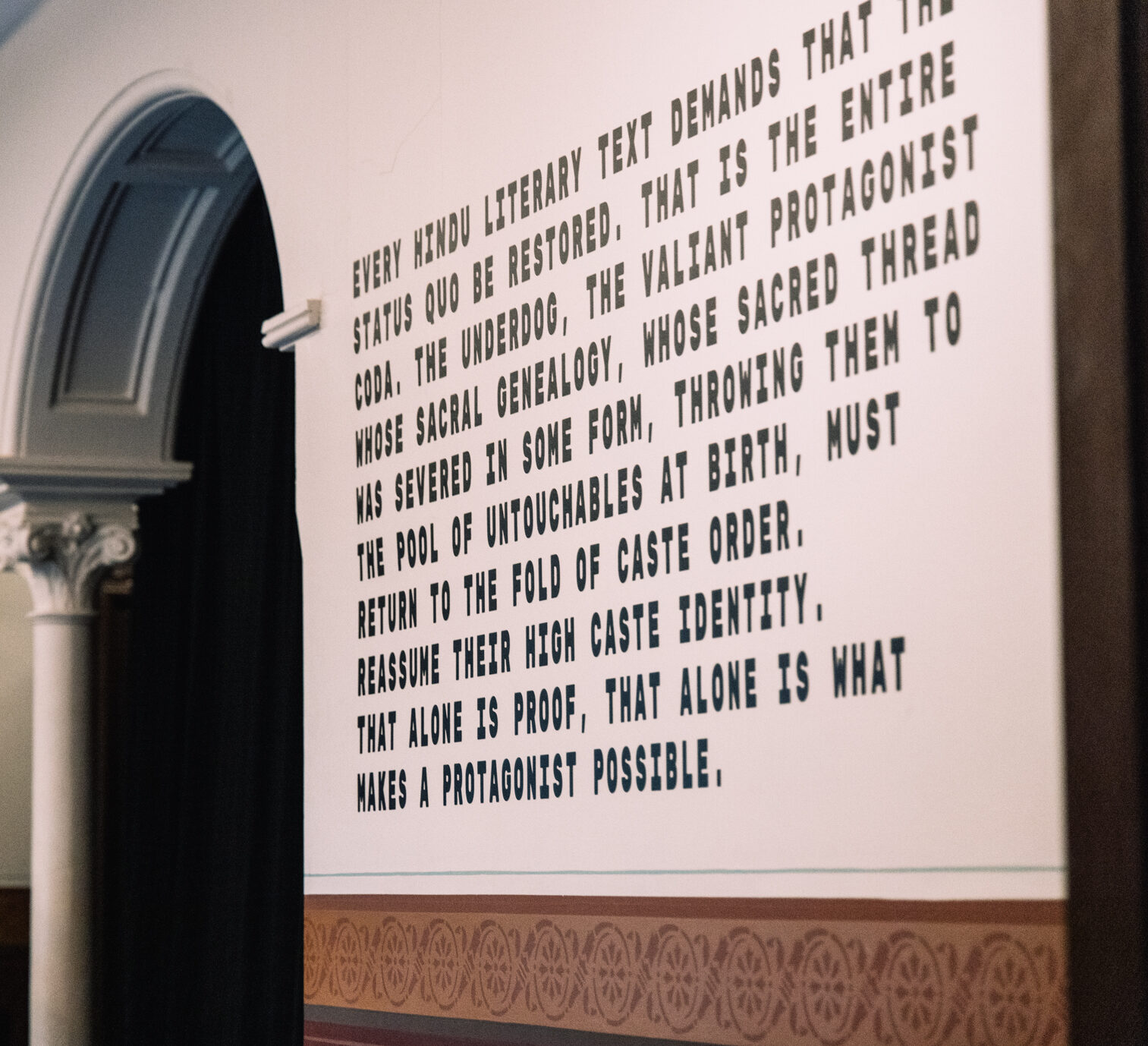Expressions of autonomy, joy, agency
Opening night remarks from Vishal Kumaraswamy
Okkoota ಒಕ್ಕೂಟ opened on 12 April 2023. Below are the opening night remarks from Guest Curator, Vishal Kumaraswamy.
Firstly, let me start by saying that April is Dalit history month and having this project open now is incredibly special to me and communities like mine.
Okkoota signifies a long-standing dream of mine to mount a curatorial endeavour that flattens the hierarchy between exhibition-making and public programming, and instead thinks through community-building as its primary focus. It is an assembly of artistic practices across multiple casteised, racialised and othered positions that are so complex in their expression that in its collective emergence, aesthetic diversity is made redundant and a demand to go beyond the bare minimum is placed in front of you today.
Okkoota builds upon Babasaheb Ambedkar’s call to Educate, Agitate and Organise by drawing from the anti-caste movement, its histories and organising principles to present artistic practices within these contested spaces. The project seeks to demonstrate ways of building equity within institutional thinking and programming by fomenting community engagement across a range of artistic, social, pedagogical and experiential outcomes.
My curatorial work thinks together with ancestral practices of gathering in my community where the event that calls for the assembly of the community is equally important to the gathering itself, thereby allowing for an assertion of presence otherwise made invisible by the control mechanisms of the caste system. This has greatly informed the need to liberate public programming from exhibition making and instead to regard the curator as a non-hierarchical conduit for the flow of information and resources from the institution to artists, a funnel for the filtering of bureaucratic considerations for free and open access pedagogy, communal meals, and often donning the role of a facilitator who helps to build capacity of audiences & artists.
“Without nourishing the body, you cannot nourish the soul, if you cannot nourish the soul, you cannot speak to the people” is a rough translation of an old saying in my community and this saying ties together the ways in which the socio-cultural memories of the spaces we inhabit form a lasting impact on our lives and thus we must nourish and care for audiences in several ways.
I’m a firm believer proximity brings value by opening up spaces for exchange of ideas and information, strategies of resistance and thinking about the organisation of gatherings in kinder, more gentle ways.
Within Okkoota, I ask: how do we engineer the flow of information, knowledge, histories, traditions and cultural practices to inform our individual path and by virtue of belonging to the communities we come from; a communal path as well to safeguard the continuity of cultural production? How do we further enmesh the socio-economic needs of the community with the future proofing of the existence of spaces for engagement & exchange well beyond individual and institutional relationships?
When I received the invitation from Nithya to visit the space and meet the people here at Arts House, I often asked myself the question about how my thinking and practice in applying anti-caste principles of building equity can be made contextualised within the framework of Arts House and the city of Melbourne? In dealing with the imposing colonial facade of the building, from the inside out, I began by recording the acoustic properties of the space to ask myself what is the sonic signature of symbols of oppression? What is the sonic landscape of the insidious intrinsic mechanisms of veil-making that belonging to a dominant group affords? The one that bestows excuse making, language-based contortions of deniability and fabricating all powerful mythologies. These questions allowed me to begin formulating a binding relationship that references the historically successful collaboration of caste and colonisation as I moved through the two post-colonies of India and Australia and reflected upon the bonds, friendships, conversations of care and studio visits with artists that reinforced my belief that artists have the full agency to tell their own stories. Thus the curatorial framework is one that builds upon the relationships and individual histories and common experiences of unbelonging to feel the power of violence within systems never built for those like us.
Throughout the project you will encounter narratives around histories of colony, displacement, ritual, family ties, labour and erasure, but I want you to remember that while the contexts that birthed these works are heavy, they are actualised expressions of autonomy, joy, agency and a reclaiming of our own stories.
I hope that within the framework of this exhibition, you will find various ways in which to engage and absorb information and activities, to bear witness and form kinships, to identify and resist that which ails us, the overbearing and oppressive force of capital, of capital derived as an artefact of the enduring colonial imperialist ideologies that surround us. I wish that to come into contact with this program is to offer ourselves knowledge and inclusion and an understanding that the onus lies with these institutions to continually work towards signalling that these doors are forever open for everyone.
We the artists, curators, participants & collaborators and our ancestors named in this series of gatherings seek the permission of original custodians of this land, the eastern Kulin nation, their elders, kin and emerging generations of peoples to mark this point in time as a moment when marginalised populations living in divergent timelines graced these structures with their presence and richness of their histories and being.
Institutions can bend when the people inside it are willing to bend but this requires care and empathy. Okkoota is an important reminder in the ethics of ceding power and the transformative potential that true, empowered inclusion brings.
Jai Bhim, Jai Savitri, Hul Johar!


